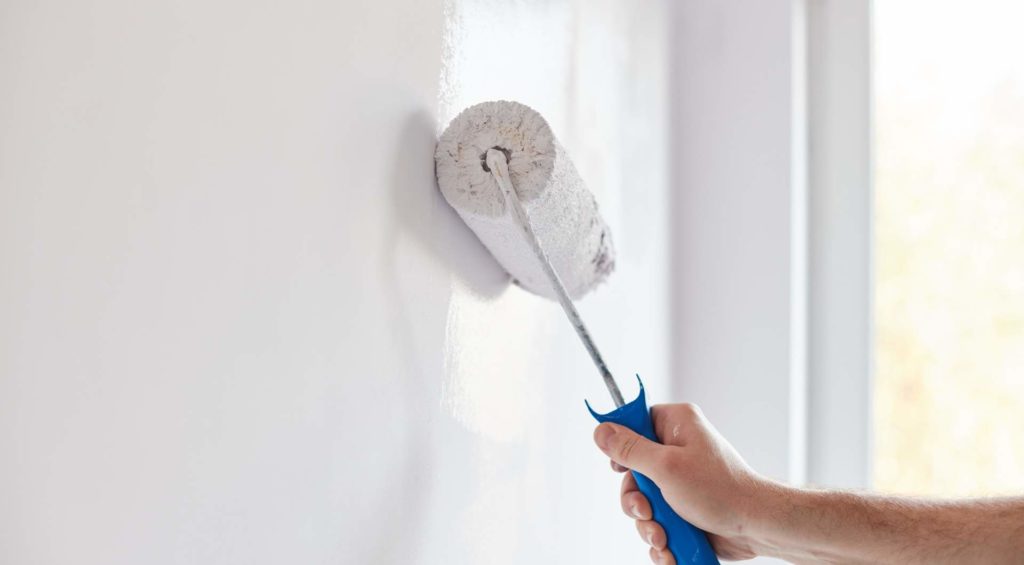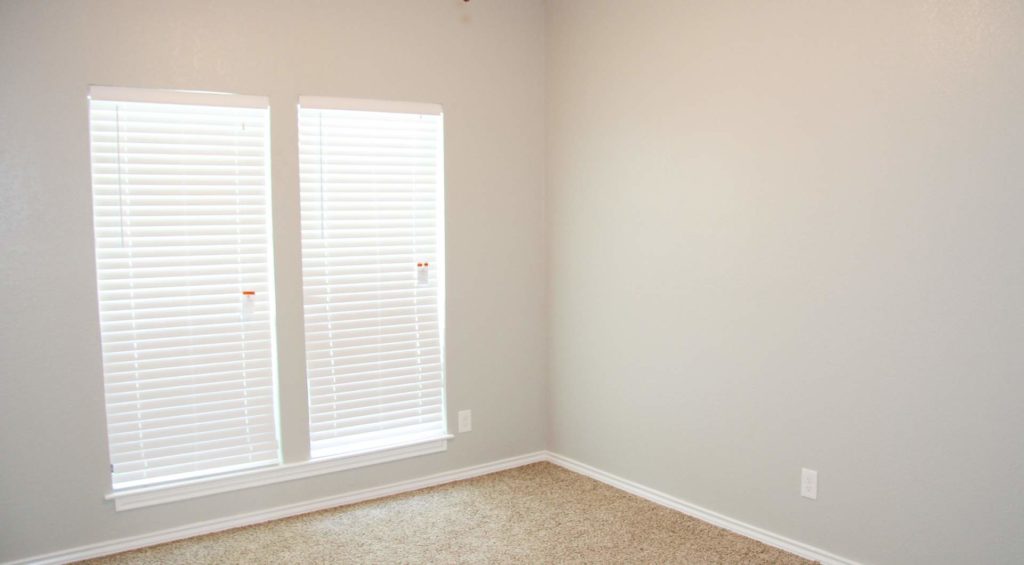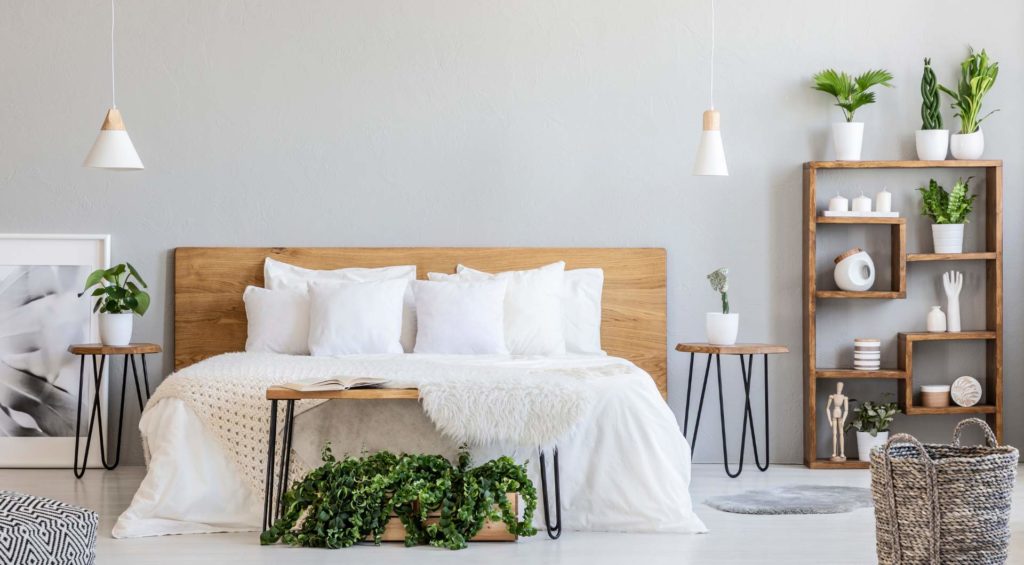Color swatches, Pinterest home design boards, and new 2024 paint trends. The budding start of repainting your bedroom can be exciting — until you have to consider the logistics.
When are you going to start? How long will it take? Do you have a lot of furniture to move? If so, where are you going to put it all?
These questions seem like big ones until you realize: if you’re painting your bedroom, where are you going to sleep?
Let’s address some questions you may have regarding when you can sleep in a room after painting and which factors you may need to remember before you whip out those paint brushes and storm off to the paint store.
Table of Contents
- How Long After Painting Can I Sleep in the Room?
- What Are VOCs?
- Do VOCs Affect How Long You Need To Wait Before Sleeping in a Freshly-Painted Room?
- Commonly Asked Questions About Sleeping in a Room After Painting
- Is It OK To Sleep in a Freshly-Painted Room?
- How Do You Ventilate a Room While Painting?
- How Long To Ventilate After Painting
- Two Brothers Painting: Top-Ranked Interior Painters in Oregon and Southwest Washington
How Long After Painting Can I Sleep in the Room?
This answer may depend on several factors, such as:
- Type of paint
- Temperature of the room
- Humidity levels
- Ventilation
It’s essential to make knowledgeable decisions when executing a DIY paint project to ensure that your finished product is stunning and your home is safe. Working with painting professionals may decrease the risks of paint fume exposure.
Along with 150 years of combined experience, our experts at Two Brothers Painting have extensive knowledge and can answer various questions, like, “When is it safe to sleep in a room after painting?”
We prefer to work around our client’s schedules to ensure they are protected against paint fumes as much as possible.
For those who find the smell of paint unfavorable, we also offer an additive that can be put into paint that smells like potpourri, citrus, clean linen, or flowers. This can cover the smell and may last for six to eight months.
What Are VOCs?
According to the Environmental Protection Agency (EPA), volatile organic compounds (VOCs) are gasses emitted from certain room-temperature liquids or solids. These gasses may sometimes be noxious chemicals that may have short- or long-term adverse health effects.
Many industrial and commercial products, such as paints and varnishes, emit VOCs if they contain compounds such as:
- Toluene
- Xylene
- Acetone
- Formaldehyde
- Benzene
- Methylene
- Chloride
Do VOCs Affect How Long You Need To Wait Before Sleeping in a Freshly-Painted Room?
Since exposure to VOCs may have short-term or lasting health effects, you might want to wait a bit before sleeping in a room after painting to reduce risks.
Ideally, you should limit your use of products that generate high amounts of VOCs and ensure that you handle paint safely and properly.
While low-VOC and no-VOC products generate little to no VOCs, there is evidence that these paints still contain a small amount. Low-VOC paint has less than 50 grams of VOCs per liter, whereas zero-VOC paint has 5 grams or less per liter.
If you are mixing color into the paint, the process may also add more chemicals that contain VOCs.
If you’re concerned about choosing the right paint type to limit VOC exposure or worried about properly handling paint, you may want to consult a professional.
Two Brothers Painting has comprehensive experience with helping clients select paint and set safety parameters to ensure the painting project decreases the potential risks associated with VOCs.
We will prioritize working around your schedule to produce high-quality work that is executed efficiently and safely.
Hybrid Latex
According to our experts at Two Brothers Painting, hybrid latex paint is one of the most commonly used types of paint for residential painting projects.
A well-ventilated room with a fresh coat of hybrid latex paint may be ready to sleep in after 12 hours.
Hybrid latex paint is a water-based alkyd resin paint.
It performs like an oil-based paint but without the solvents or the odor. While this paint has a slight odor, hybrid latex paints contain less VOCs than their oil-based counterparts, making them a safe choice for your home and the environment.
Oil
Oil-based paints are solvent-based, tend to take longer to dry, and emit higher levels of VOCs.
You may want to wait up to 24 hours before sleeping in a room after painting with this type of paint. During this time ensure that the room is well-ventilated, preferably with a fan blowing towards as many open windows as possible.
Two Brothers Painting reports that oil paint is rarely used for walls but may be chosen for:
- Cabinets
- Trim
- Millwork
- Doors
Zero VOC
Our experts at Two Brothers Painting say you can immediately sleep in a room painted with zero VOC paint once it dries.
Evidence suggests that zero VOC paint only has trace emission levels for six hours or less after application.
This type of paint is most often used in areas where odor sensitivity may be an issue, such as a child’s room or a hospital/doctor’s office. Although there may be a slight odor, it is much less noticeable than oil-based or hybrid-latex paints. However, it may be slightly more expensive.
Commonly Asked Questions About Sleeping in a Room After Painting
What Are the Side Effects of Harmful Paint Fumes?
Exposure to paint fumes and VOCs may cause a variety of short-term health effects, including:
- Eye, nose, and throat irritation
- Headaches
- Nosebleeds
- Dizziness or lightheadedness
- Nausea
- Difficulty breathing
If you have been exposed to paint fumes and experience any of the above-mentioned symptoms, immediately vacate the area and go outdoors. The symptoms typically go away once you have been exposed to fresh air. If they do not, please consider seeking medical advice from a healthcare professional.
Research suggests that long-term exposure to paint fumes and VOCs may be associated with increased health risks, such as:
- Cancer
- The development of allergies, asthma, and sick building syndrome
- Damage to the nervous system, liver, and kidneys
Is It OK To Sleep in a Freshly-Painted Room?
It depends on which paint is used and who the occupants are. Certain individuals may be more at risk when sleeping in a painted room than others, they include:
- Children
- Older individuals
- Pregnant people
- Persons with respiratory conditions
Two Brothers Painting reports that most clients do not mind sleeping in a freshly painted room, so long as the fumes are not a safety hazard.
When clients are concerned about paint fumes or can not tolerate the smell of paint, Two Brothers Painting goes above and beyond to accommodate them.
As a leading Portland painting company, we treat every home as if it were our own. For 20 years, customers in Portland Metro, Beaverton, Tigard, Bethany, Lake Oswego, West Linn, Clackamas, and Hillsboro have relied on our experienced and skilled professionals to produce high-quality work.
Join the list of our many satisfied clients by allowing us to service your commercial or residential space.
Is It OK To Sleep in a Freshly-Painted Room if I’m Pregnant?
Currently, no significant evidence suggests water-based, low/zero VOC house paint negatively affects pregnancy and fetal development.
Assuming you are using low- or zero-VOC paint, you should be fine sleeping in a painted room after it dries.
If you choose to paint or decorate your nursery while pregnant, you may reduce potential risks by:
- Avoiding freshly painted rooms until at least week 13 of your pregnancy (the most significant risks may be during fetal organ development, which happens during one to 12 weeks).
- Using latex water-based paints instead of solvent-based oil paints.
- Ventilating all rooms by opening windows and doors.
- Wearing protective clothing such as gloves, long pants, face masks, long-sleeved tops, and goggles.
- Not consuming food or drink in the room you’re decorating.
- Washing your hands once you’ve finished painting to avoid accidentally ingesting any of the paint.
Solvent-based paints like oil paints, however, have been associated with:
- Miscarriages
- Congenital abnormalities
- Reduced fetal growth
Is It OK To Sleep in a Freshly-Painted Room if I Have Allergies?
Environmental irritants such as paint fumes may trigger conditions like asthma or allergies. Since latex paints are made with synthetic rubber products, they generally do not affect people with natural latex allergies.
A 2010 study that investigated the VOC levels in the bedrooms of children found that a specific type of VOC called propylene glycol may lead to an increased risk of developing conditions such as asthma, eczema, and rhinitis.
Is It OK for Small Children To Sleep in a Freshly-Painted Room?
Generally, low- and zero-VOC paints will be safe for your child to sleep in once the paint has dried.
Two Brothers Painting always suggests these types of paint when discussing plans to paint a child’s room.
You may not want to allow your small child to sleep in a freshly painted room until a few days have passed and the fumes have dissipated. This is to prevent any irritation associated with paint odors, such as respiratory issues or nausea.
How Do You Ventilate a Room While Painting?
The U.S. Consumer Product Safety Commission (CPSC) suggests these tips to ventilate a room before and after painting:
- Carefully read and follow all instructions and precautions on the paint’s safety label.
- Open all doors and windows to the outside (but not to hallways).
- Use a fan on the far side of the room pointing at an open window/door or a box fan in a window blowing out.
- Continue to ventilate the painted room.
- Follow the paint can directions when cleaning painting equipment and disposing of or storing unused paint.
Two Brothers Painting always suggests that clients who are concerned about paint fumes take a mini vacation or schedule painting projects during times they know they will be away.
This will give our painting professionals plenty of time to ventilate the house and prepare for the finished project’s unveiling.
How Long To Ventilate After Painting
The U.S. Consumer Product Safety Commission suggests that you continue to provide ventilation for a room for at least two to three days or until there is no longer any paint odor.
Two Brothers Painting: Top-Ranked Painters in Oregon and Southwest Washington
We are the Pacific Northwest painters you can trust to deliver a high-quality painting project that is mindful of your safety, schedule, and property.
We are Two Brothers Painting.
For over 20 years, we have had the privilege of serving our wonderful community while impacting homes and businesses alike.
We offer an array of award-winning painting services for your commercial or residential property, including:
- Interior painting
- Exterior painting
- Pressure washing
- Cabinet painting and refinishing
- Exterior stains and finishes
- Color-matching and sampling
Let Two Brothers Painting assuage any concerns with paint safety and your home with our highly skilled expertise and comprehensive knowledge. Schedule a consultation with us today.





